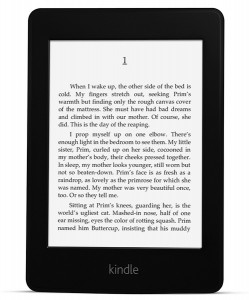 Based on shipping time alone, the Kindle Paperwhite seems to be a huge success. Â There’s currently a 5-7 week lead time on ordering one, which makes it already iffy even for a Christmas gift. Â But if you’re shopping for an ebook reader this season, the Paperwhite is the one to get.This is my third Kindle, after leaving #2 on a plane (which I still kick myself for), and the paperwhite has a series of refinements that have been a long time coming.
Based on shipping time alone, the Kindle Paperwhite seems to be a huge success. Â There’s currently a 5-7 week lead time on ordering one, which makes it already iffy even for a Christmas gift. Â But if you’re shopping for an ebook reader this season, the Paperwhite is the one to get.This is my third Kindle, after leaving #2 on a plane (which I still kick myself for), and the paperwhite has a series of refinements that have been a long time coming.
The most visible addition is the lit screen. Â Previous Kindles offered add-on cases which included a light, but this is right in the device itself. Â It’s bright enough to read in the dark, but also dim enough to let my wife sleep next to me while I read. Â There’s a slight shadowing effect at the bottom of the screen, but it only bugged me for a minute or two before I learned to ignore it.
Less visible but equally welcome is the capacitive touchscreen.  Previous models used IR to detect taps, which was sometimes inaccurate or frustrating to use.  The difference is subtle, but the results are much more responsive.  And while I don’t pretend to know the technical reasons behind this, the Paperwhite’s screen also seems to repel smudges and dust better than the previous model’s did.
The Kindle home screen & menus received their first overhaul ever, and it’s a welcome arrival. Â Cover images now feature prominently instead of just text, and overall it’s a easier to navigate around. Â That said, I’m annoyed that roughly 1/3 of the home screen is taken up by a display of popular books available for purchase. Â And this is on the model that supposedly has no ads.
Now the smaller improvements:
One of my pet peeves about the Kindle line up until now is that I never felt connected to my location in a book. Â While it was easy to see my progress through the book as a percentage, it was harder to know how long it’ll be until I finish a chapter and reach a good stopping point. Â The Paperwhite fixes that with math! Â It watches my reading pace, then predicts how many minutes it’ll be until I finish a chapter. Â And so far it’s been pretty accurate.
I still wish the Paperwhite had physical page-turn buttons in the same way the Nook has preserved that option. Â But when placed in the optional Kindle case, the Paperwhite’s bezel is very slightly wider than the case on older models. Â It’s a small difference, but it makes it much more comfortable to rest my thumb there while reading.
The Paperwhite’s case has a smartcover-style wake feature. Â Open it up, and the device unlocks. Â Close it, and it re-locks. Â This is again a small bonus, but an appreciated one.
Lastly, the negatives:
The Paperwhite has no audio output. Â It can’t read the book to you like other models can, and you can’t listen to mp3s on it either. Â I don’t think I ever used either of those features, so I don’t mind the loss. But if either are critical to your use, keep it in mind.
The new capacitive screen is great, but it doesn’t work with gloves.  I read at the bus stop every morning, and in the winter this makes it trickier to turn pages.  The older IR touchscreens could be poked with anything, gloved or not.
In conclusion, I feel like the lit screen will be the last major innovation in e-ink readers for a while. Â I could be wrong about that, but the Kindle paperwhite feels like a device with the feature list I’ve always wanted.